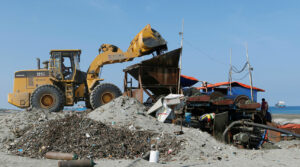
DoF proposes key changes to mining fiscal reform bill
By Aaron Michael C. Sy, Reporter
THE FINANCE department is proposing a simplified fiscal regime for the Philippine mining industry that is seen to generate as much as P10 billion in additional revenues every year.
In a statement, the Department of Finance (DoF) said it is pushing for the Rationalization of the Mining Fiscal Regime, “which aims to simplify the tax system, ensure the government’s fair share in mining revenues, and establish good governance in the mining industry.”
The DoF said its proposal is simpler than House Bill (HB) No. 8937 as it adopts fewer tiers and rates for easier compliance and implementation. The House of Representatives approved HB 8937 on third and final reading in September 2023.
Under the DoF’s new proposal, large-scale metallic mining operations inside mineral reservations will still pay the government 5% of their gross output. This is higher than the 4% under the House bill.
Margin-based royalties on income from metallic operations will be imposed on those outside mineral reservation areas.
The DoF is proposing a margin-based royalty rate of 1.5-5% with only four tiers, unlike the House version that proposes 1-5% with eight tiers. For instance, miners with margins of 1% but not over 20% would be subject to a 1.5% rate.
“Compared to the eight-tier structure from HB 8937, four-tier makes it simpler for investors and the Bureau of Internal Revenue (BIR) to compute the corresponding tax rates. Furthermore, the simplified DoF version will lessen incentives for the private sector to pursue aggressive accounting to avoid taxes,” the DoF said.
The DoF is also proposing to simplify the windfall profit tax to just four tiers, from 10 tiers under the House bill.
For example, miners with margins of 26% but not more than 45% will be subject to 1.5%, while those with margins of more than 75% will be imposed a 10% rate.
“Similarly, a four-tier, compared to the 10-tier structure in HB 8937, margin-based windfall profits tax rate ranging from 1.5% to 10% on income from mining operations is proposed in light of the sudden increases in the world prices of metal,” the DoF said.
Based on its new proposal, the DoF expects the “compromise” mining fiscal regime to generate an average of P10.23 billion a year from 2025 to 2028.
Broken down, the government expects to generate an annual average of P5.55 billion from royalty tax on miners inside mineral reservations, P1.31 billion from royalty tax on miners outside mineral reservations, and P3.37 billion from the windfall profit tax.
“We began discussions to rationalize our country’s mining fiscal regime in 2012, yet the Philippines’ mining potential remains untapped. With this proposal, the nation will finally receive its rightful share of mining revenues to fund the country’s development goals,” Finance Secretary Ralph G. Recto said in a statement.
Mining companies in the country currently pay corporate income tax, excise tax, royalty, local business tax, real property tax, and fees to indigenous communities.
The Rationalization of the Mining Fiscal Regime is part of the Legislative-Executive Development Advisory Council’s (LEDAC) list of 20 priority measures and is one of President Ferdinand R. Marcos, Jr.’s priority bills.
“This is just the first step. We can be a major player in this global economy in terms of mineral production. We just have to realize it with the right policies,” Finance Assistant Secretary Karlo Fermin S. Adriano said.
Sought for comment, Chamber of Mines of the Philippines (CoMP) Chairman Michael T. Toledo said the proposed four-tier royalty rate will result in an increase in the annual effective tax rate to 60.6% from the 59.6% under HB 8937. This would be higher than those in Indonesia, Chile, Peru, South Africa, and Canada.
“The DoF proposal, therefore, will make the mining tax structure even more uncompetitive,” Mr. Toledo said in a Viber message.
The CoMP also proposes a four-tier regime, but one that starts at 1%. Mr. Toledo said this would make it easier for the BIR to implement without affecting the country’s competitiveness as a mining investment destination.
Meanwhile, Regina Capital Development Corp. Head of Sales Luis A. Limlingan said the DoF proposal could make the Philippines more attractive to mining investments.
“But it depends on how many firms can benefit from 1% versus 1.5% and whether they meet the minimum (income margin) to be entitled to it,” he said in a Viber message.



